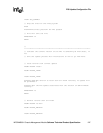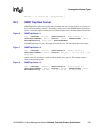
MPCMM0001 Chassis Management Module Software Technical Product Specification 253
Unrecognized Sensor Types
Unrecognized Sensor Types 28
28.1 System Events Overview
When a System Event is recorded in the CMM’s System Event Log (SEL), it contains 16 bytes.
Below is an overview of the meaning of the bytes. For more information see Table 26-1 in the IPMI
1.5 specification.
Record ID – (2 bytes) The record ID of the SEL record.
Record Type – (1 byte) The type of the record. For 1.5 the values are 02h = System Event Record,
C0h – DFh = OEM Timestamped, and E0h – FFh = OEM non-timestamped. However, for future
proofing, the CMM must be able to report any record type from 00h – FFh. The ability to translate
bytes below this point only applies to System Event Record and OEM Timestamped records. For
OEM non-timestamped, all remaining bytes are OEM specified.
Timestamp – (4 bytes) The time the event was received by the CMM. The ability to translate bytes
below this point only applies to System Event Record. For OEM timestamped, all remaining bytes
are OEM specified.
Generator ID – (2 bytes) Specifies what entity in the shelf generated the event. Normally this will
be the IPMB address of the entity.
EvM Format – (1 byte) The event message format. The CMM supports 03h and 04h formats.
Sensor Type – (1 byte) Sensor Type Code for the sensor that generated the event. See Table 36-3 in
the IPMI 1.5 specification for the Sensor Type Codes.
Sensor Number – (1 byte) The number of the sensor that generated the event.
Event Dir – (high bit of 1 byte) Defines if the event is being deasserted (1b) or asserted (0b).
Event Type Code – (low 7 bits of 1 byte) Type of trigger for the event. There are three general
categories: A) Generic, B) Sensor Specific, and C) OEM. The Generic category has values of 01h –
0Ch. The Sensor Specific is defined as 6Fh. The OEM range is 70h – 7Fh. However, for future
proofing, the CMM must be able to report any Event Type from 00h to FFh. See Sections 36-1, 36-
2, and 36-3 of IPMI 1.5 spec for more information.
Event Data 1 – (1 byte) How to interpret the bits in this byte depends on the class of the sensor.
There are three general classes: A) Threshold, B) Discrete, and C) OEM. Generally speaking, the
high nibble of this byte defines what type of data is in Event Data 2 and 3. Bits 7:6 define Data 2
usage and 5:4 define Data 3 usage. A value of 00b means that data byte is not used. A value of 01b
for threshold sensors means that the data byte 2 or 3 contains the trigger reading or threshold value,
respectively. A value of 01b for a discrete or OEM class sensor means that data byte 2 contains the
previous state/severity and for data byte 3 it is a reserved value. A value of 10b means that the
respective data byte contains OEM data. A value of 11b is reserved for OEM sensors and for the
other two means that a sensor-specific offset is held in the data byte.
The low nibble defines an offset within the threshold, discrete, or OEM tables.


















